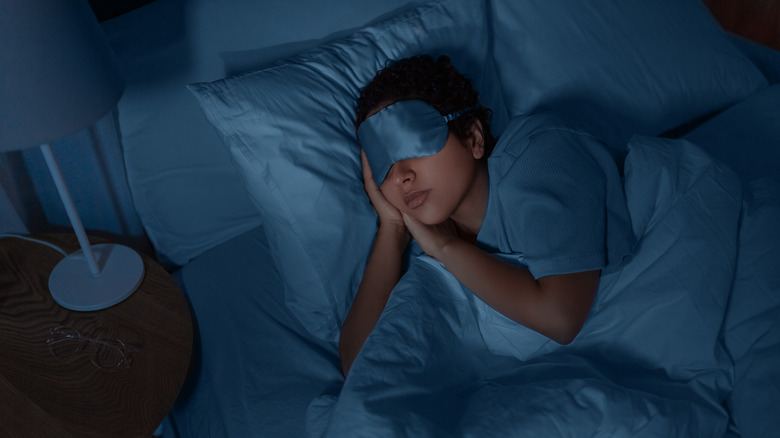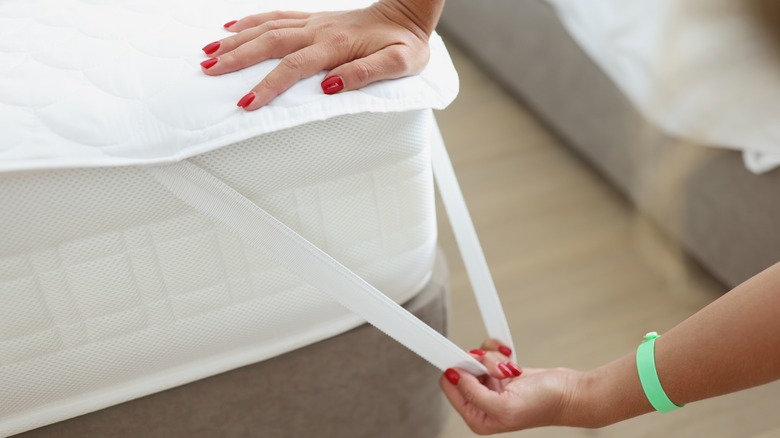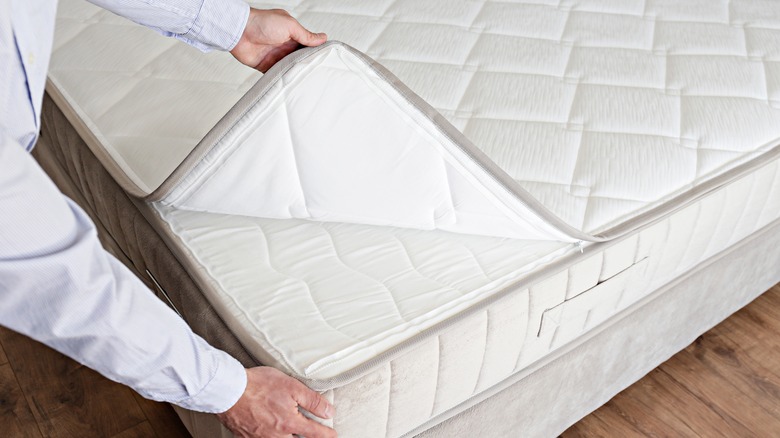How Often Should You Be Cleaning Your Mattress Protector?
While a mattress is a huge investment in comfort, a mattress protector is a great accessory to protect that investment. Mattress protectors are waterproof materials that secure the mattress against stains and wear, making it last longer.
Mattress protectors are not the same as mattress pads or mattress toppers. They don't provide extra cushioning and are actually made to be thin so that you can still feel the mattress (via Mattress Nerd). The protector material you choose will depend on your bed needs. Do you produce a lot of body heat at night and expect a lot of moisture on the protector? Mattress Nerd says you'll need one with performance fabric, which is the most expensive. There are also options for those that prefer materials that are organic, breathable, or cheaper.
Fitted, encasement, and elastic strap are the three main types which are made to fit the bed differently. The fitted type is applied just like a fitted sheet, encasement protectors will cover the mattress fully and close with a zip, and elastic strap protectors are attached firmly to the mattress with straps. Regardless of the type or the material, it's important to know how and when to clean your mattress protector.
How to clean your mattress protector
The Spruce suggests washing your mattress protector every month, or every two weeks if you have allergies, a cold, or an infectious illness. For a significant spill, it should be washed right away. Your mattress protector will probably be machine washable and should be handled according to the instructions provided (via Family Handyman).
The Spruce provides a comprehensive washing guide. Before washing, make sure to treat any stains that you see individually. Then, wash with detergent except when it's a fabric that has down filling. Wash it with cold or warm water on the bulky or normal setting and dry on the normal dryer setting or air dry. Avoid bleaching or dry cleaning because that can affect the materials in the protector. If you can't wash your protector in the machine, you'll have to clean each stain by hand and then air dry (via Casper).
Natural cleaners are generally recommended because normal detergent usually contains harsh chemicals that the protector shouldn't absorb.
How to maintain your mattress protector
If you invest in a quality mattress protector, you'll need to take proper care of it so you can get your money's worth. For brand new protectors, wash them before the first use in order to break them in. After it's been in use for a while, rotate it frequently in order to balance it out and avoid it getting dented in some areas, says Family Handyman. A few drops of essential oils while drying can also provide some extra freshness to your protector (via Avocado Help Center).
Does your mattress protector need a repair? See if it's something that can be fixed or mended, or if the protector needs to be replaced completely, says The Spruce. Make sure to fold or roll it properly if it needs to be put away in storage.
If the protector is in a guest room or on a bed that isn't used frequently, it doesn't need to be washed like normal but should be cleaned every two to three months due to dust, advises Amerisleep. Water spills on waterproof protectors may not need to be washed but will need to be soaked up with a towel.
When to replace your mattress protector
To stay healthy and maintain the best level of comfort possible, it's necessary to know when it's time for a new mattress protector. A quality protector that is maintained properly should last between two to three years, according to Family Handyman. Two to three years is the general lifespan of a protector, whether there are signs of damage or not, because of all the substances it absorbs over time.
If it's not washed well or with the right frequency, your mattress protector will have to be replaced earlier. When there are clear signs of damage like rips or holes, that also means it's time to get a new one. Other signs of damage include seams that have burst open or weird odors that won't go away (via Everlasting Comfort).
When it's time to say goodbye to your protector, you don't have to throw it away! Family Handyman suggests upcycling it into other household items like the filling for your decorative pillows or cushions for your pets.



